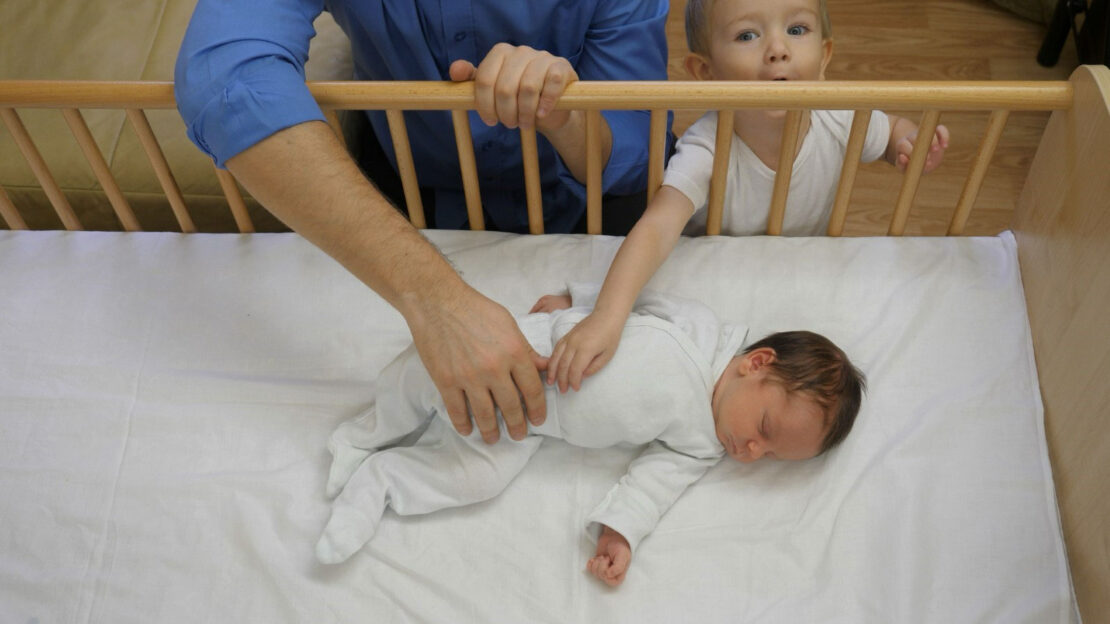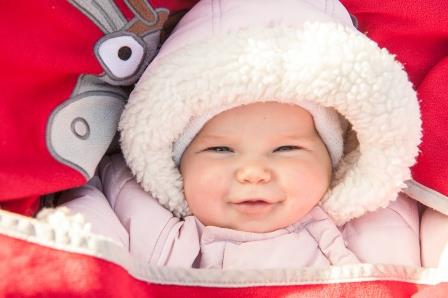In the winter you will want to make sure that your home is warm enough for your baby but not too hot.
In your Home
- Dress your baby as you would dress yourself. If you are comfortable in pants and a light sweater, your baby will be too.
- The temperature in your home should be:
- at least 21°C in the day (7a.m. to 11 p.m.).
- no lower than 18°C at night (11 p.m. to 7 a.m.)
Did you know?
If you rent, you can ask your landlord to follow these recommendations. If your landlord does not comply, you can call the Residential Tenancies Branch at 204-945-2476 or toll free 1-800-782-8403.
In the Crib or Bassinet

The safest place for a baby to sleep is in a crib, cradle or bassinet in your room for the first six months, or ideally, for the first year.
- Dress baby in one-piece footed sleepers. For an extra layer, use a onesie or undershirt.
- Use a flannel fitted sheet in your baby’s crib.
- Crib or bassinet should not be near radiators, heaters, fireplaces and woodstoves, windows, drafts and outside walls.
- Babies may need a hat to stay warm if the room is too cold.
- Do not use hot water bottles or electric blankets, these could cause a burn or your baby to overheat.
If baby is still cold and you want to use a blanket in a crib
Use a crib-sized blanket. It should be large enough to be firmly tucked in without coming loose, but small enough so it does not make the mattress uneven when tucked in.
- Lay baby on back with feet near the bottom of the crib.
- Place blanket so that it is no higher than baby’s armpits.
- Tuck the blanket into the sides and bottom of the crib.
Out and about
Dress your baby for the weather
- Keep your baby warm by dressing them in layers that are easy to put on and remove.
- Mitts, socks, boots will help keep your baby warm.
- A warm hat is important because babies lose a lot of heat through their heads.
- When you go indoors remove or at least unzip baby’s snowsuit and take off the hood or hat to prevent overheating.
Did you know?
When using a stroller or sled, exercise can make you feel warm, though your baby is just sitting and will feel the cold much more than you.
Winter Car Seat Safety
Here are some tips to keep your child warm and safely buckled in their car seat.
As a general rule, infants should wear one more layer than adults. If you’re wearing a coat, your baby will likely need a coat and a blanket, too. Just remember to take off the coat and blanket once you’re inside the car before buckling your child into the car seat. A safer option is to drape a blanket or coat over the car straps after your baby is buckled in.
Your baby needs to be dressed warmly in the winter. Choose a snowsuit that isn’t puffy or made from slippery material. Take care that your baby’s snowsuit or other clothing doesn’t interfere with the fit of the car seat:
When clicking your baby in:
- Only one finger should fit between the car seat straps and your baby’s collarbone.
- The chest clip should be at armpit level.
If you are using a blanket:
- Make sure it is no higher than baby’s armpits
- Never place the blanket behind or under baby.
If you are using an infant car seat cover:
- Only use the infant car seat covers briefly when taking baby outside.
- Remove the cover as soon as you are inside or in the vehicle.
- Only use the car seat covers that go over the car seat. Do you use the ones that go under your baby.
How to tell if your baby is cold
- Feel their under their armpits, or their thighs if they are cold. Cold hands and feet do not always mean that the baby is cold.
- They are fussy
- Their skin looks pale or blotchy
To warm your baby
- Hold Them Close – skin to skin is best
- Add Layers – Start with close-fitting layers like a onesie and then add a blanket or a warm sleeper. Make sure the blanket is not too tight around their chest and always leave their face uncovered.
- Adjust the Room Temperature – you may need to turn room temperature up


